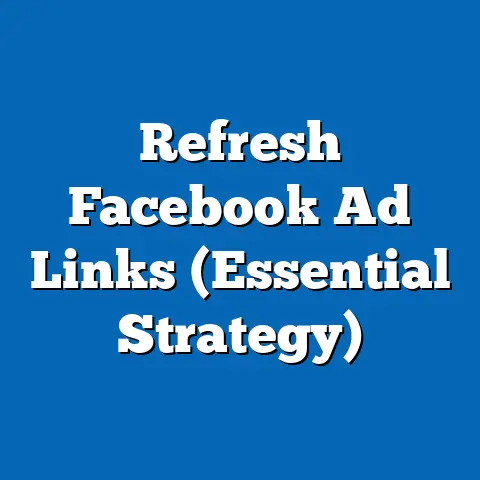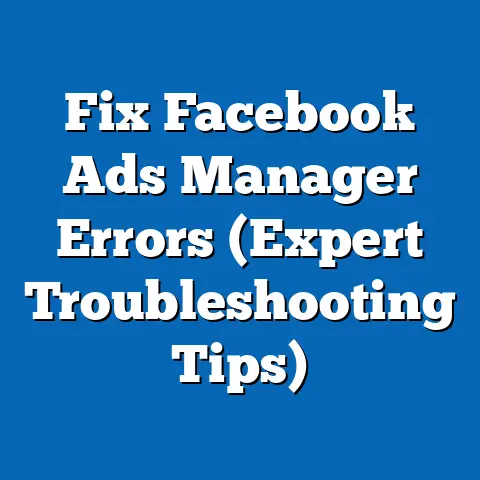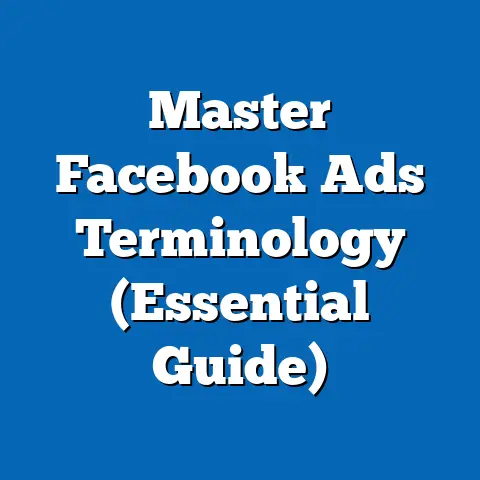Unlock Insights: Download Facebook Ads Report (Data-Driven Trends)
Many marketers believe that Facebook Ads are no longer effective in reaching target audiences due to the rise of other platforms like TikTok and Instagram. I’ve heard it countless times, and honestly, there was a point where I wondered if the golden age of Facebook Ads was behind us. But here’s the thing: dismissing Facebook entirely is a mistake. The platform is constantly evolving, and with the right data-driven strategies, it can still be a powerhouse for reaching your target audience and achieving your business goals. That’s why understanding and leveraging Facebook Ads Reports is more critical than ever.
In this article, I’m going to dive deep into the world of Facebook Ads Reports. I’ll walk you through why data is so crucial in modern advertising, how to download and utilize these reports, and what key trends are shaping the Facebook advertising landscape right now. Forget the outdated notions; we’re going to unlock real insights that can transform your advertising efforts.
The Importance of Data in Facebook Advertising
Let’s face it: in today’s digital world, gut feelings and hunches just don’t cut it anymore. Data is the lifeblood of successful advertising, and that’s especially true on Facebook. We live in an era where consumers are bombarded with ads, making it harder than ever to stand out. Data allows us to cut through the noise and make informed decisions about who we’re targeting, what messages resonate, and where our budget is best spent.
Think of it this way: imagine you’re trying to find the best route to a new destination. Would you wander aimlessly, hoping to stumble upon the right path? Or would you use a map or GPS to guide you? Data is your GPS in the world of Facebook Ads. It provides a clear roadmap, helping you navigate the complexities of the platform and reach your destination – your target audience – with precision.
Unveiling Facebook Ads Reports
Facebook Ads Reports are your primary source of data. They’re essentially comprehensive dashboards that provide a detailed overview of your ad performance. But they’re more than just a collection of numbers; they’re a goldmine of actionable insights waiting to be unearthed. These reports offer a granular view of everything from engagement metrics to conversion rates, demographic breakdowns, and overall ad performance.
Here’s a glimpse of the type of data you can expect to find:
- Engagement Metrics: This includes likes, comments, shares, and clicks. Analyzing these metrics helps you understand how your audience is interacting with your ads. Are people simply scrolling past, or are they actively engaging with your content?
- Conversion Rates: This is where you see how many people are taking the desired action after seeing your ad, whether it’s making a purchase, signing up for a newsletter, or downloading a resource. Conversion rates are a direct indicator of your campaign’s effectiveness.
- Demographic Breakdowns: This section provides a detailed look at the age, gender, location, and interests of the people who are seeing and interacting with your ads. This information is invaluable for refining your targeting and ensuring you’re reaching the right audience.
- Ad Performance: This encompasses a wide range of metrics, including reach, impressions, frequency, cost per click (CPC), and cost per conversion. These metrics give you a holistic view of how your ads are performing and where you can make improvements.
Takeaway: Data is essential for making informed decisions in Facebook advertising. Facebook Ads Reports provide a wealth of information that can help you optimize your campaigns and achieve your business goals.
Key Trends in Facebook Advertising (2024)
The Facebook advertising landscape is constantly shifting. What worked last year might not work today. Staying ahead of the curve requires a keen understanding of current trends and how they impact your advertising strategy.
Here are some of the key trends I’m seeing right now:
The Evolution of Audience Targeting
Gone are the days of broad targeting. Today, success hinges on reaching the right people with the right message at the right time. Facebook’s audience targeting capabilities have become increasingly sophisticated, allowing you to create highly specific audiences based on a variety of factors.
- Lookalike Audiences: This feature allows you to create audiences that resemble your existing customers or website visitors. By analyzing the characteristics of your best customers, Facebook can identify other users who share similar traits and are therefore more likely to be interested in your products or services.
- Custom Audiences: This allows you to upload your own customer data, such as email lists or phone numbers, and target those individuals directly on Facebook. This is particularly effective for retargeting campaigns or for reaching existing customers with special offers.
- Detailed Targeting: This feature allows you to target users based on their interests, behaviors, demographics, and more. This gives you granular control over who sees your ads and ensures you’re reaching the most relevant audience.
The Rise of Video Content
Video is king, and that’s especially true on Facebook. Video ads are more engaging than static images, and they’re more likely to capture the attention of users who are scrolling through their newsfeeds. This is why I’ve seen so many brands shifting their focus towards video content in recent years.
- Facebook Stories and Reels: These short-form video formats have exploded in popularity, and they offer a unique opportunity to reach a younger audience. They’re perfect for showcasing behind-the-scenes content, running quick promotions, or simply engaging with your audience in a fun and authentic way.
- Live Video: Live video is another powerful tool for building engagement and connecting with your audience in real-time. It’s perfect for hosting Q&A sessions, product demonstrations, or simply sharing your thoughts and insights.
The Power of Retargeting Campaigns
Retargeting is the art of showing ads to people who have already interacted with your brand in some way, whether they’ve visited your website, viewed a product page, or added an item to their cart. Retargeting campaigns are incredibly effective because they target people who are already familiar with your brand and are therefore more likely to convert.
Example: Imagine someone visits your online store and browses a specific product but doesn’t make a purchase. With retargeting, you can show them ads for that product on Facebook, reminding them of their interest and encouraging them to complete the purchase.
Takeaway: Facebook advertising is constantly evolving. Staying ahead of the curve requires a keen understanding of current trends, including the evolution of audience targeting, the rise of video content, and the power of retargeting campaigns.
Understanding Your Audience Through Facebook Ads Reports
Facebook Ads Reports provide a treasure trove of demographic insights that can help you understand your audience on a deeper level. By analyzing these insights, you can create targeted ad campaigns that resonate with specific segments of your audience and drive better results.
Here’s how to interpret some of the key demographic data:
- Age and Gender: This data can help you understand the age and gender distribution of your audience. Are you primarily reaching men or women? Are you targeting the right age group for your products or services?
- Location: This data can help you understand where your audience is located geographically. Are you reaching people in the right regions or cities?
- Interests: This data can help you understand the interests and hobbies of your audience. Are you targeting people who are genuinely interested in your products or services?
Example: Let’s say you’re running a campaign to promote a new line of hiking boots. By analyzing your Facebook Ads Reports, you discover that the majority of your audience is between the ages of 25 and 45, lives in urban areas, and is interested in outdoor activities like hiking and camping. With this information, you can refine your targeting to focus on these specific demographics, ensuring that your ads are seen by the people who are most likely to be interested in your products.
Takeaway: Facebook Ads Reports provide valuable demographic insights that can help you understand your audience on a deeper level. By interpreting these insights, you can create targeted ad campaigns that resonate with specific segments of your audience and drive better results.
Measuring Success with Key Performance Indicators (KPIs)
Tracking the right Key Performance Indicators (KPIs) is essential for measuring the success of your Facebook ad campaigns. Without clear metrics, it’s impossible to know whether you’re achieving your goals or wasting your money.
Here are some of the essential KPIs that I always monitor in my Facebook Ads Reports:
- Click-Through Rate (CTR): This is the percentage of people who see your ad and click on it. A high CTR indicates that your ad is relevant and engaging to your target audience.
- Cost Per Click (CPC): This is the amount you pay each time someone clicks on your ad. A low CPC indicates that you’re getting good value for your advertising spend.
- Conversion Rate: This is the percentage of people who take the desired action after clicking on your ad, whether it’s making a purchase, signing up for a newsletter, or downloading a resource. A high conversion rate indicates that your ad is effective at driving results.
- Return on Ad Spend (ROAS): This is the amount of revenue you generate for every dollar you spend on advertising. A high ROAS indicates that your ad campaigns are profitable.
Setting Benchmarks:
It’s important to set benchmarks for these KPIs so you can track your progress and identify areas for improvement. What constitutes a “good” CTR, CPC, or conversion rate will vary depending on your industry, target audience, and advertising goals. However, there are some general guidelines you can follow.
Example: Let’s say you’re running an e-commerce store that sells clothing. You might set a benchmark of a 1% conversion rate for your Facebook ad campaigns. This means that for every 100 people who click on your ad, you want at least one of them to make a purchase. If your conversion rate is consistently below 1%, you know you need to make some changes to your ads or your landing page to improve your results.
Takeaway: Tracking the right KPIs is essential for measuring the success of your Facebook ad campaigns. By setting benchmarks for these KPIs, you can track your progress, identify areas for improvement, and ensure that you’re getting the most out of your advertising spend.
The Role of A/B Testing in Optimizing Facebook Ads
A/B testing, also known as split testing, is a powerful technique for optimizing your Facebook ads. It involves creating two or more versions of an ad and showing them to different segments of your audience to see which one performs better.
Here’s why A/B testing is so important:
- It Eliminates Guesswork: Instead of relying on hunches or assumptions, A/B testing allows you to make data-driven decisions about your ads.
- It Identifies What Works: By testing different variations of your ads, you can identify the elements that resonate most with your audience and drive the best results.
- It Improves Your ROI: By optimizing your ads through A/B testing, you can improve your CTR, conversion rate, and ROAS, ultimately boosting your bottom line.
How to Conduct A/B Tests:
- Identify a Variable to Test: This could be anything from the headline or image to the call-to-action or targeting options.
- Create Two or More Variations: Create different versions of your ad, each with a different value for the variable you’re testing.
- Run Your Ads: Use Facebook’s A/B testing feature to show the different variations to different segments of your audience.
- Analyze the Results: After a set period of time, analyze the results of your A/B test to see which variation performed better.
- Implement the Winning Variation: Implement the winning variation in your ad campaigns to improve your results.
Example: Let’s say you’re running an ad to promote a free e-book. You might want to A/B test two different headlines to see which one generates more clicks. You could create one ad with the headline “Download Your Free E-Book Today” and another ad with the headline “Learn the Secrets to [Your Industry] Success.” By running these two ads side-by-side, you can see which headline generates more clicks and use that headline in your future campaigns.
Takeaway: A/B testing is a powerful technique for optimizing your Facebook ads. By testing different variations of your ads, you can identify the elements that resonate most with your audience and drive the best results.
How to Download and Utilize Facebook Ads Reports
Downloading and utilizing Facebook Ads Reports is a straightforward process, but it’s important to know the steps involved and how to interpret the data.
Step-by-Step Guide to Downloading Facebook Ads Reports:
- Go to Ads Manager: Log in to your Facebook account and navigate to the Ads Manager.
- Select Your Campaigns: Choose the campaigns you want to generate a report for.
- Click “Reports”: In the top menu, click on the “Reports” tab.
- Customize Your Report: Choose the metrics, dimensions, and date range you want to include in your report.
- Download Your Report: Click the “Export” button and choose the format you want to download your report in (e.g., CSV, Excel).
Choosing the Right Format:
The format you choose will depend on how you plan to analyze the data. CSV (Comma Separated Values) is a simple text format that can be easily imported into spreadsheets or databases. Excel is a more user-friendly format that allows you to create charts and graphs.
Tips for Organizing and Storing Reports:
- Create a Consistent Naming Convention: Use a consistent naming convention for your reports so you can easily identify them later (e.g., “Facebook Ads Report – [Campaign Name] – [Date Range]”).
- Store Reports in a Central Location: Store your reports in a central location, such as a cloud storage service or a shared folder, so everyone on your team can access them.
- Back Up Your Reports: Back up your reports regularly to prevent data loss.
Takeaway: Downloading and utilizing Facebook Ads Reports is a straightforward process. By following these steps, you can access the data you need to optimize your campaigns and achieve your business goals.
Future Predictions for Facebook Advertising
Looking ahead, I see several key trends shaping the future of Facebook advertising.
- Increased Focus on Privacy: With growing concerns about data privacy, Facebook is likely to continue to implement changes that limit the amount of data advertisers can collect. This means that advertisers will need to become more creative and rely on first-party data to target their audiences.
- The Rise of AI and Machine Learning: AI and machine learning are already playing a significant role in Facebook advertising, and I expect this trend to continue. AI-powered tools can help advertisers optimize their campaigns, target their audiences more effectively, and personalize their ad creative.
- The Metaverse and Virtual Reality: As the metaverse and virtual reality become more mainstream, Facebook is likely to explore new advertising opportunities in these immersive environments. This could include sponsoring virtual events, creating branded virtual experiences, or placing ads within virtual worlds.
Adapting to Stay Ahead:
To stay ahead of the curve, advertisers will need to:
- Embrace First-Party Data: Focus on collecting and utilizing your own customer data to target your audiences.
- Experiment with AI-Powered Tools: Explore the many AI-powered tools that are available to help you optimize your campaigns.
- Stay Informed About Emerging Trends: Keep up-to-date on the latest trends in Facebook advertising and be prepared to adapt your strategies accordingly.
Takeaway: The future of Facebook advertising is likely to be shaped by increased focus on privacy, the rise of AI and machine learning, and the emergence of the metaverse and virtual reality. By adapting to these trends, advertisers can continue to succeed on the platform.
Conclusion
Let’s recap: Facebook Ads Reports are your secret weapon for unlocking powerful advertising potential. While some marketers might be quick to dismiss the platform, I firmly believe that with a data-driven approach, Facebook Ads can still deliver incredible results. By leveraging the insights from these comprehensive reports, you can make informed decisions, target your audience more effectively, and optimize your campaigns for maximum impact.
Don’t let misconceptions hold you back. Embrace data as a crucial component of your advertising strategy, and regularly download and analyze your Facebook Ads Reports to stay informed and competitive. The digital landscape is constantly evolving, and the only way to stay ahead is to be data-driven.
Call to Action:
Ready to transform your advertising efforts? Take the first step by downloading your latest Facebook Ads Report today! Start uncovering the insights that can help you reach your target audience, optimize your campaigns, and achieve your business goals. And don’t forget to share your findings and experiences in the comments below or on social media. I’m eager to hear how data is helping you succeed with Facebook Ads!





